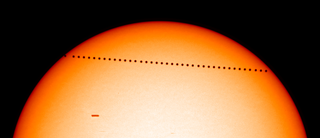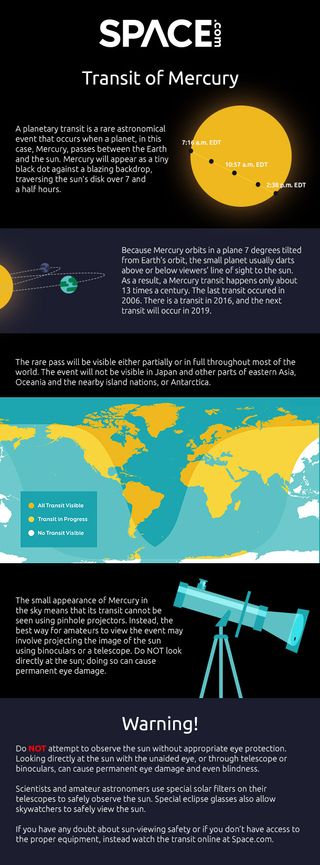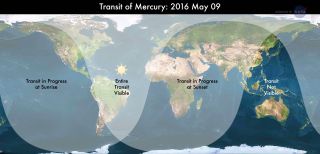The Mercury Transit: How to See the Rare Event Online on Monday

Tomorrow, (May 9) Mercury will pass directly across the face of the sun — an event that won't happen again until 2019. If you're not able to watch the event live, there are a multiple ways to follow the action online.

As seen from Earth, Mercury will begin inching its way across the face of the sun at about 7:12 a.m. EDT (1112 GMT) Monday morning, and ending at about 2:40 p.m. EDT (1840 GMT). The event — which astronomers call a transit of Mercury — will be visible across all of North America, but it will begin before sunrise for those in the west.
For skywatchers who can't see Mercury's transit of the sun where they are (or even for those who can), there are plenty of ways to watch this event online. The Slooh Community Observatory will host a free, live webcast. You can watch the Mercury transit broadcast at Slooh's website. It will begin at 7 a.m. EDT and run through 2:45 p.m. EDT (1100 to 1745 GMT), the duration of the transit.
You can also watch the webcast live on Space.com, courtesy of Slooh. [The Mercury Transit of May 9, 2016: Full Coverage]
The broadcast will include multiple views of the transit from different locations around the world, as well as commentary from astronomy experts and other guests. During the broadcast, viewers can share photos of the event, chat with audience members, interact with the hosts, and personally control Slooh's telescopes. Go to the observatory website to find out how.

Transit science on NASA TV

From 10:30 to 11:30 a.m. EDT (1430 to 1530 GMT) on Monday, NASA will broadcast a live discussion about the science behind the Mercury transit. The broadcast will feature an "informal roundtable" with experts in planetary science, heliophysics and astrophysics, according to the agency. Viewers can ask the panel of experts questions via Facebook and Twitter using the hashtag #AskNASA.
You can watch the broadcast on NASA TV, or here on Space.com.
Get the Space.com Newsletter
Breaking space news, the latest updates on rocket launches, skywatching events and more!
Participating in the roundtable will be: Jim Green, planetary science director at NASA Headquarters in Washington; Lika Guhathakurta, heliophysics program scientist at NASA Headquarters; Nicky Fox, project scientist for the Solar Probe Plus mission at Johns Hopkins University Applied Physics Laboratory; and Doug Hudgins, Exoplanet Exploration Program scientist at NASA Headquarters.
In addition, look for photos of the transit from NASA's Solar Dynamics Observatory satellite, which will be uploaded here throughout the event.
More transit webcasts
But that's not all, skywatchers. There are multiple webcasts that will feature footage of the transit from various locations.
- The European Space Agency will be webcasting live views of the transit throughout the day. The stream will begin at 5:30 a.m. EDT (0930 GMT), and will first feature a Spanish language introduction, followed by an English language introduction beginning at 6:20 a.m. EDT (1020 GMT). There will be a general presentation in English from 8:00 a.m. to 11:00 a.m. EDT (1200 to 1500 GMT), followed by a general presentation in Spanish from 11:00 a.m. to 2:15 p.m. EDT (1500 to 1815 GMT).
- The Griffith Observatory in Los Angeles will broadcast its live view of the transit beginning at sunrise (6 a.m. PDT) and lasting until the transit is complete at 11:45 a.m. PDT. Note that the observatory is closed to the public on Mondays, so there will be no viewing event on the observatory campus.
- The Virtual Telescope Project will also host a free, live webcast featuring view of the transit, which you can watch here. The broadcast will begin at 7 a.m. EDT (1100 GMT). The webcast will feature live commentary by astrophysicist and founder of the Virtual Telescope Project, Gianluca Masi.
- The Mt. Lemon SkyCenter, located just north of Tucson, Arizona, will be uploading images of the transit to its Facebook page. Check under the "LIVE from the SkyCenter" tab to see the latest images.
Enjoy the show!
Editor's note: Visit Space.com on Monday to see live webcast views of the rare Mercury transit from Earth and space, and for complete coverage of the celestial event. If you SAFELY capture a photo of the transit of Mercury and would like to share it with Space.com and our news partners for a story or gallery, you can send images and comments in to managing editor Tariq Malik at spacephotos@space.com.
Follow Calla Cofield @callacofield.Follow us @Spacedotcom, Facebook and Google+. Original article on Space.com.
Join our Space Forums to keep talking space on the latest missions, night sky and more! And if you have a news tip, correction or comment, let us know at: community@space.com.

Calla Cofield joined Space.com's crew in October 2014. She enjoys writing about black holes, exploding stars, ripples in space-time, science in comic books, and all the mysteries of the cosmos. Prior to joining Space.com Calla worked as a freelance writer, with her work appearing in APS News, Symmetry magazine, Scientific American, Nature News, Physics World, and others. From 2010 to 2014 she was a producer for The Physics Central Podcast. Previously, Calla worked at the American Museum of Natural History in New York City (hands down the best office building ever) and SLAC National Accelerator Laboratory in California. Calla studied physics at the University of Massachusetts, Amherst and is originally from Sandy, Utah. In 2018, Calla left Space.com to join NASA's Jet Propulsion Laboratory media team where she oversees astronomy, physics, exoplanets and the Cold Atom Lab mission. She has been underground at three of the largest particle accelerators in the world and would really like to know what the heck dark matter is. Contact Calla via: E-Mail – Twitter
